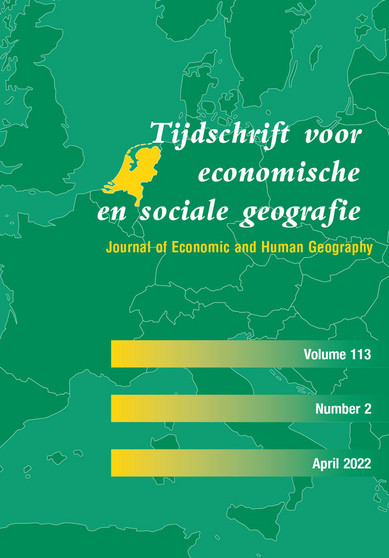Main Content
New Paper: Berlin Fashion Designers between Online and Offline Spaces

IRS doctoral researcher Alica Repenning is investigating the spaces of creative work in fashion design in her PhD project in the research area “Economy and Civil Society”. Her paper “Workspaces of Mediation: How Digital Platforms Shape Practices, Spaces and Places of Creative Work” has now been published in the journal “Tijdschrift voor Economische en Sociale Geografie (TSEG)”. The analysis of Berlin fashion designers shows that they move in a complex web of digitalised work spaces, work locations and work practices. Digital platforms such as Instagram help to determine this network through their structures and mechanisms.
Working Spaces between Online and Offline Interactions
Organising, being creative, working with textiles, networking, sharing images on Instagram, setting up the online shop - these are some elements of the work of fashion designers in Berlin. Online and offline spaces, practices and interactions are often difficult to distinguish.
Under the title “Workspaces of Mediation”, Alica Repenning therefore builds a bridge between the literature on geographies of the digital and research on work in the creative industries. The concept of “spatial mediation” proves to be particularly fruitful in understanding how online and offline spaces and interactions come together, influence each other and overlap in everyday life. The example of Berlin fashion designers shows that many everyday processes of fashion design are closely intertwined with the digital surfaces of platforms. Here, the global platform corporations orchestrate and circulate information from networked individuals and companies. The resulting extended digital work environment of fashion designers influences work practices, work spaces and work locations.
Along these three dimensions, online and offline spheres are closely intertwined. Therefore, the paper methodologically relies on a combination of online and offline observations conducted in tandem with qualitative interviews. Fashion designers in Berlin and other people in the fashion industry were interviewed. Repenning's colleague Anna Oechslen was also present for the first nine interviews. One of the interviews was conducted by three people, together with the dissertation supervisor Suntje Schmidt. In addition to offline observations at fashion weeks, markets or in design studios, online observations were primarily made on the Instagram platform, on websites and in online shops. The qualitative data mix provided a detailed picture of the practices, places and spaces of fashion designers in Berlin.
Digital Components of the Studio, the City, the Designer and her Work
The search for inspiration, for example, no longer takes place offline, but is also shifted to online spaces. However, the designers have to actively detach themselves from the information on the platform so that they can realise ideas that are new and creative instead of replicating what already exists. The reputation of the brand and the design are also built in an interlocking of online and offline interactions and indicators. The designers describe how the platform helps them to present themselves and build a brand, but at the same time has pitfalls, as a lot of work goes into creating a digital reputation, the results of which are difficult to predict and track.
Fashion designers' workspaces have also experienced a digital extension through the Instagram platform. The studio, the city, and the brand's district are given a digital component that is cultivated and staged specifically, or even incidentally. GPS references and images of the studio or the city are examples of these digital spatial references. The designers consciously decide which references to Berlin or their district they use, or whether they show more pictures from Paris or Milan in order to build up an international image of the brand and thus signal a certain professionalism. A variety of interactions at local or international fashion weeks can also be witnessed immediately via the platform by means of videos or images.
Interaction via the digital platform has also led to an expansion of work locations. One designer describes how he prepares an Instagram post in bed on Sunday morning. This example shows that digital spaces are often closely linked to everyday actions and places, leading to an increased mixing of work and everyday life. For example, even if a designer goes for a walk with a friend and takes a picture of an urban atmosphere, which she then shares on Instagram, the place becomes a place of work in a broader sense. At the same time, this impression of the city of Berlin is shared with an international network and has a close atmospheric connection to the designer and her clothes. Another designer describes that he keeps checking in between to see who has reacted to his posts, viewed them or left a comment, so that he often reaches for his mobile phone to retrieve this information - wherever he happens to be. In addition, people can find out what's happening in their personal and professional networks at any time and in any place.
Alica Repenning conducted the research for this publication as part of the lead project “Platform Ecology: Creative Collaboration in the Field of Tension between Virtual and Concrete Spaces Using the Example of Fashion Design” together with Oliver Ibert, Suntje Schmidt and Anna Oechslen in the research group “Creativity and Work”. This is the first of three planned articles as part of Repenning's cumulative dissertation in the Department of Economic Geography at Humboldt University Berlin. The second paper will shed light on the frictions that arise when part of the workspace is structured by global digital corporations that steer user practices according to very specific corporate logics. In another publication, the on/offline strategies of individual creative entrepreneurs will be examined more closely in order to understand platform-based entrepreneurial practices more precisely and to uncover new digital dependencies.
Repenning, Alica (2022): Workspaces of Mediation: How Digital Platforms Shape Practices, Spaces and Places of Creative Work. Tijdschrift voor Economische en Sociale Geografie, 113 (2), 211-224.

